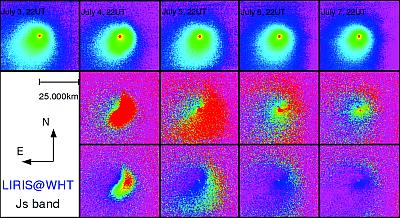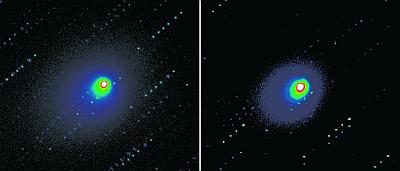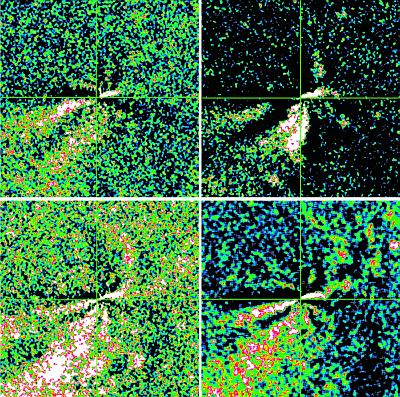 | |||
|
| Home > Public Information > Scientific Highlights > 2005 > The Deep Impact Event at the ING Telescopes |
|
The Deep Impact Event at the ING Telescopes
WHT+LIRIS, INT+WFC
The NASA Deep Impact mission consisted in two spacecrafts: an impactor, weighting 364 kg; and a flyby spacecraft for observing the impact and relaying data from the impactor.
The main goal of the mission was to study the interior and outer layers of a comet. Until the impact, very little was known of the internal structure and the physical evolution of the outer layers of a comet nucleus.
Most of what we know relies primarily on theoretical models. The relationship between the coma’s composition and the nucleus composition is also uncertain.
Even if the coma is formed by material from the nucleus, there are several physical and chemical processes that rapidly affect the material ejected from the nucleus.
Comets are remnants of the early stages of the formation of our Solar System and thus contain the most pristine material from that era, as well as clues to its subsequent evolution. Whatever evidence we have into their internal composition comes either from remote observation and modelling of the dust and gases that are lifted off the surface, or from in-situ analysis of data from recent spacecraft flybys. Deep Impact was designed to provide a first look at the interior of a comet by striking the surface to expose the material underneath the opaque crust. The target comet was comet 9P/Tempel1. This is one of a class of comets known as the Jupiter-family of comets, most of which are believed to have formed in the trans-Neptunian region. These objects have low inclination orbits and typically take less than 20 years to orbit the Sun. Their orbits are strongly influenced by Jupiter, hence their name. 9P/Tempel 1 orbits the sun once every 5.5 years, and the Deep Impact encounter was scheduled to take place at perihelion, when the comet was at 1.5 and 0.9 Astronomical Units from the Sun and Earth, respectively. Deep Impact was designed so that much of the mission-critical science would be done from Earth-based telescopes. These facilities would observe the comet before, during, and after impact. This was an unprecedented coordinated observational campaign, which included over 550 whole or partial nights of observation using 73 ground-based telescopes at 35 observatories. These facilities would observe the comet’s evolution in wavelength regimes and timescales inaccessible to the spacecraft (The Tempel1 Observing Collaborators Team). The Roque de Los Muchachos Observatory played a substantial role in this campaign. Observations started in 2000. But the interesting part of the game started on July 2nd, 2005. From July 2nd to July 10th a campaign involving three telescopes of the observatory, the WHT, the TNG and the NOT was driven by a group led by ING astronomer Javier Licandro. LIRIS at the WHT was used from July 3rd to 7th to obtain near infrared images in the J and K bands and near infrared spectra. Also another group lead by Stephen Lowry (QUB) used the INT and the Liverpool Telescope to follow the activity of the comet from July 1st to 7th. The five largest telescopes of the Roque de Los Muchachos Observatory were used simultaneously to track an astronomical experiment in an unprecedented way.
On July 3rd, 2005 the Deep Impact impactor probe successfully separated from its mother craft onto a trajectory that would plunge the probe into the nucleus of comet 9P/Tempel1 at a velocity of 10 kms–1. At 05:44:36 UT on July 4th the impactor collided with the comet producing an impact of 19 GJ of kinetic energy and excavating a crater shaped by gravity. The first aim of the campaign was to study the dust ejected by the impact by using the high S/N images obtained in the visible and near infrared, and the spectra in the near infrared where there are many features due to gas emission. The evolution of the intensity and colour of the dust gives important information on the size of the ejected grains, like their size distribution and ejection velocities. The second aim of the campaign was to measure possible variations of the gas emission by means of visible spectroscopy, to detect any possible new activity in case the impactor penetrated deep enough to meet the fresh ices below the dust mantle. This would evaporate part of them and expose ices to the sun-light generating a new active area. The impact produced an ejecta cloud of dust easily seen in the images. The wonderful atmospheric conditions (all nights were photometric, and the seeing was as good as 0.4arcsec) allowed the astronomers to obtain a set of excellent images in particular in the R and J bands. At these wavelengths the images were sampling the reflected sunlight by the dust in the coma. The spectra also showed that the gas contribution was very low in particular in the near infrared. Some conclusions about the dust cloud ejecta follow:
The observations from the INT were very important for completing the time base coverage of the comet as it fell below the sky from the primary observing site at Mauna Kea, Hawaii. The observing slot ran from July 1st to July 7th, 2005. A period which overlapped the Deep Impact encounter allowed the observers three nights pre-impact and four nights post impact observing. The strategy was to use the Wide Field Camera to obtain image mosaics up to 5 million kilometres along the projected anti-solar direction to look for ion-tail features that may have been produced as a result of the impact. The post impact observations quickly revealed that no such ion features were present, which was subsequently confirmed by other observers performing similar programs. With this in mind it was decided to focus on deep optical imaging of the central gas and dust coma through UBVr'i'O+ filters. When the comet was imaged on July 4th, about 16 hours after the impact, the comet was seen to have increased in brightness by a factor of two —as measured in the central pixel— compared to the July 3rd pre-impact levels. Some dramatic changes were seen in the dust coma. The Deep Impact event did not create a new period of sustained cometary activity, and in many ways the artificial impact resembled a natural outburst.
In conclusion, the impact was an impulsive event that affected the dust mantle of the comet. A large amount of dust was ejected into the coma in a very short time. In no more than 5 days this dust dissipated.
Also, if the impactor reached the fresh-ices below the dust mantle, it did not excavate enough to expose a sufficient amount of ices to create a new region sufficiently active to be easily detected.
References:
|
| Top | Back |
|





